Characterization of the Dominant Stages at Which Gas Flaring Is Introduced: Impacts and Policy Options to Ameliorate Them
Abstract
1. Introduction
Perspective and Issues Addressed
2. Rationale, Methods, Contributions
2.1. Quality of Life and the Three Pillars of Sustainability
2.2. The Concept of the Time of Intervention and the Motivation of the Study
2.3. The Area of Study
3. Impacts of Gas Flaring on the Environment
3.1. Thermal Effects
3.2. Carbon Emissions
3.3. Quality of Rain and Ground Water
4. Impacts of Gas Flaring on the Society
4.1. The Quality of Aquatic Life and Fishing Yield
4.2. The Recorded Noise Levels in the Area
4.3. Crop Production
4.4. Health Impacts
5. The Economic Impacts of Gas Flaring
5.1. Costs Due to Corrosion
5.2. Gas Flaring Costs
6. Dominant Stages at Which Gas Flaring Is Introduced
Pathways to Gas Flaring and Relationships with the Flaring Stages
7. Policies to Eliminate Gas Flaring
7.1. Present State of Gas Flaring and Prevention Policies
7.2. Preventive Policy Measures at the Design Stage of the Oil Field Facility (Pre-Flaring Stage)
Adequate Pre-Flare Legislation Is Required, and Implementation Is Necessary
- The permissions to flare should be an explicit part of the proposed associated gas legislation described in (1.) above. Presently, these are handled by three different departments: the Department of Petroleum Resources (DPR), the Federal Environment Protection Agency, and the Environment Impact Assessment unit [75].
- It should be required that an oil exploration/production operator seeking a permit to operate should show evidence of associated gas utilization options (covering the routine, non-routine, and safety flaring pathways (see Table 2)) at the design stage, and, if the permit is granted, incorporate the appropriate gas utilization measures during the exploration, construction, and utilization phases of the facility. The Norwegian Petroleum Directorate has successfully applied a similar approach [76].
- The siting of new oil production facilities should be subject to restrictions in terms of distance to existing habitations based on evidence from the number of studies so far indicating the societal effects of gas flaring. This is to mitigate the health impacts.
7.3. Policy Options at Existing Oil Production Facilities (Flaring Stage)
Strengthen and Implement Existing Legislation
- Strengthen the Flare Gas (Prevention of Waste and Pollution) Regulations, 2018 [80], which is an update of the Associated Gas Reinjection Act of 1979 (which has a gas re-injection clause), with the flare penalties updated, to accommodate the nature of existing oil production facilities; existing facilities should be made to adopt currently feasible anti-flare measures.
- Establish a realistic flare-out deadline agreed upon with the stakeholders. It is best to identify key points and risks associated with the implementation of the desired gas utilization programs with the stakeholders, so that these can be tackled in a realistically timely way. Previous flare-out deadlines in 1984, 2004, and 2008 have all been missed [81], possibly because the stakeholders were not consulted in setting the targets, and they may have been unrealistic. The last flare-out deadline, for 2020 [31,81], was not met, because of this historical approach to establishing gas flare-out policies.
- Review the current flaring penalties with the oil companies, to possibly increase them each year, using the annual consumer inflation figure or some other agreed-upon escalator. Even though it was reviewed in 2018 for the first time since 1998, if all the oil companies were penalized at the upper limit of the new tariff (USD 2 per 1000 ft3 of gas flared [80]) and these were collected at the same proportion as reported previously [75], the total amount would add up to just over USD 9.7 million. Given that a gas-to-liquid plant could cost over GBP 2 billion to build [1] and mini-gas-to-liquid plants might require an investment of up to USD 140 million [65], it is still much cheaper to pay the penalties to flare gas than to utilize the flared gas.
- Involve smaller gas utilization operators in the gas flare management and incorporate policies (1 to 3) above in the arrangements. The Nigerian Gas Flare Commercialization Programme was set up to carry out and strengthen this type of policy [31] but it does not incorporate these three (1 to 3) measures enumerated above. Smaller gas utilization operators range from gas collection, storage, and distribution companies to operators of small to medium-sized power plants used in industries and residential estates.
- Strengthen the Department of Petroleum Resources [or similar departments] to train their personnel to measure, monitor, and report gas flares and enforce gas flare legislation and guidelines more effectively. This will enhance the monitoring of flares through the three stages of gas flare introduction and persistence (Figure 5). There has been uncertainty in the past about the actual number of gas flare sites in the region [82]. This makes policy decisions more difficult and less suitable.
7.4. Policy Options for the Affected Communities (Post-Flaring Stage)
7.4.1. Evacuation from Habitations Close to Gas Flare Sites
7.4.2. Improve National Macro-Economic Planning and Management, and Back This with Resource Allocation
7.4.3. Water Treatment
7.4.4. Corroding Roofs
7.4.5. Health Care
7.4.6. Education
7.5. The Science–Policy Gap Needs to Be Closed (Pre-Flaring, Flaring, Post-Flaring Stages)
- Increase the funding for scientific research on the impacts of gas flaring on the environment, the society, and the economy of the Niger Delta region. Engage academic experts in these areas. For example, although much of the retarding influence of gas flares on plant growth may be due to increases in soil temperature, there are indications that chemical products of the flares have impacts, such as sulfuric acid, which is responsible for acid rain, and carbon dioxide and methane, which are responsible for the greenhouse effect; chemicals also affect the surrounding vegetation, as some studies have pointed out [84]. An analysis of the composition of gas flare emissions and the impacts of polycyclic aromatic hydrocarbons (PAHs) will provide significant insight into the broader impacts of gas flaring. Studies should be intensified with respect to this to fully characterize the synergistic effects of the various pollutants emitted by the flares.The health and environmental (water, soil, air) effects should be rigorously studied by research institutions. The safe limits of habitation, farming, and fishing with regard to the distance to flare points must be determined scientifically. For example, an oil company had previously commissioned a study to disprove the link between acid rain and corroding roofs before this link was confirmed in a scientific study [63].To start with, a specific funding pool dedicated to these studies can involve funding calls over a period of 5 years, with each call addressing particular topics of need; something similar to the European Commission’s Horizon framework of funding calls could work [85].
- Data quality and management must be improved. Researchers and other stakeholders report inconsistent data; the variability makes interpretation difficult. For instance, the Nigerian Gas Flare Commercialization Programme, while putting out tenders for the utilization of gas from flare points, discovered that there were 38 more flare points than were previously known [34]; this complicated the commercialization process. Global surveys of natural gas flaring are now reliant on the use of VIIRS satellite-based sensors, which can detect and measure radiant emissions from gas flares from which the flared gas volume can then be estimated ([30], and Figure 4B). However, there are concerns that the increasing use of enclosed combustors, which enclose the flares in oil production facilities, might impede flare detection using VIIRS sensors [86]; thus, there might be gaps in the available data. Therefore, increased funding for staff training and the latest technological tools for acquiring gas flaring data are needed for effective data collection and management. There should be access to the flare gas data by personnel from other government agencies, and academic researchers. For instance, the 2018 flare gas guidelines appear to restrict the gas flare data for commercial reasons [80]. Emerging data collection issues, such as those due to enclosed flares in oil production facilities [86] must be understood. These gas flare data should also be compared with global trends, and the comparison could partly inform policy decisions.
7.6. Discussion and Limitations of the Study
8. Conclusions
Funding
Data Availability Statement
Acknowledgments
Conflicts of Interest
Correction Statement
References
- Ojijiagwo, E.; Oduoza, C.F.; Emekwuru, N. Economics of gas to wire technology applied in gas flare management. Eng. Sci. Technol. Int. J. 2016, 19, 2109–2118. [Google Scholar] [CrossRef]
- Ismail, O.S.; Umukoro, G.E. Global impact of gas flaring. Energy Power Eng. 2012, 4, 290–302. [Google Scholar] [CrossRef]
- Caseiro, A.; Gehrke, B.; Rücker, G.; Leimbach, D.; Kaiser, J.W. Gas flaring activity and black carbon emissions in 2017 derived from the Sentinel-3A Sea and Land Surface Temperature Radiometer. Earth Syst. Sci. Data 2020, 12, 2137–2155. [Google Scholar] [CrossRef]
- Shojaei, S.M.; Vahabpour, A.; Saifoddin, A.A.; Ghasempour, R. Estimation of greenhouse gas emissions from Iran’s gas flaring by using satellite data and combustion equations. Integr. Environ. Assess. Manag. 2023, 19, 735–748. [Google Scholar] [CrossRef] [PubMed]
- Omobolanle, O.C.; Ikiensikimama, S.S. Gas flaring: Technicalities, challenges, and the economic potentials. Environ. Sci. Pollut. Res. 2024, 31, 40838–40850. [Google Scholar] [CrossRef] [PubMed]
- Tran, H.; Polka, E.; Buonocore, J.J.; Roy, A.; Trask, B.; Hull, H.; Arunachalam, S. Air quality and health impacts of onshore oil and gas flaring and venting activities estimated using refined satellite-based emissions. GeoHealth 2024, 8, e2023GH000938. [Google Scholar] [CrossRef] [PubMed]
- Bennett, A. The Impact of Hydraulic Fracturing on Housing Values in Weld County, Colorado: A Hedonic Analysis; Colorado State University: Fort Collins, CO, USA, 2013. [Google Scholar]
- Agerton, M.; Gilbert, B.; Upton, G.B., Jr. The economics of natural gas flaring and methane emissions in US shale: An agenda for research and policy. Rev. Environ. Econ. Policy 2023, 17, 251–273. [Google Scholar] [CrossRef]
- Willyard, K.A. An historical political economy analysis and review of Texas oil and gas well flaring laws and policy. Energy Policy 2019, 128, 639–647. [Google Scholar] [CrossRef]
- Ojijiagwo, E.N.; Oduoza, C.F.; Emekwuru, N. Technological and economic evaluation of conversion of potential flare gas to electricity in Nigeria. Procedia Manuf. 2018, 17, 444–451. [Google Scholar] [CrossRef]
- Calel, R.; Mahdavi, P. The unintended consequences of antiflaring policies—And measures for mitigation. Proc. Natl. Acad. Sci. USA 2020, 117, 12503–12507. [Google Scholar] [CrossRef]
- Statistical Review of World Energy 2024, Energy Institute. 2024. Available online: https://www.energyinst.org/statistical-review (accessed on 20 June 2024).
- Aigbe, G.O.; Stringer, L.C.; Cotton, M. Gas Flaring in Nigeria: A Multi-level Governance and Policy Coherence Analysis. Anthr. Sci. 2023, 2, 31–47. [Google Scholar] [CrossRef]
- Jatto, A.L.A. Impact of Oil and Gas Exploration and Infrastructure in Niger Delta on the United Nations Sustainable Development Goals. In Oil and Gas Pipeline Infrastructure Insecurity: Vandalism, Threats, and Conflicts in the Niger Delta and the Global South; Springer Nature: Cham, Switzerland, 2024; pp. 81–130. [Google Scholar]
- Okwelum, C.O. Revisiting the disconnection between State Policies and Gas Flare down in Nigeria. Int. J. Multidiscip. Res. Growth Eval. 2023, 4, 109–117. [Google Scholar]
- De Vries, B.J.; Petersen, A.C. Conceptualizing sustainable development: An assessment methodology connecting values, knowledge, worldviews and scenarios. Ecol. Econ. 2009, 68, 1006–1019. [Google Scholar] [CrossRef]
- Van Egmond, N.D.; De Vries, H.J.M. Sustainability: The search for the integral worldview. Futures 2011, 43, 853–867. [Google Scholar] [CrossRef]
- Purvis, B.; Mao, Y.; Robinson, D. Three pillars of sustainability: In search of conceptual origins. Sustain. Sci. 2019, 14, 681–695. [Google Scholar] [CrossRef]
- Aktar, K.F.; Basak, R.; Ara, S.; Mahmud, A. Impacts of gas flaring on soil physicochemical and microbial properties: A case study on kailashtila gas field. Heliyon 2024, 10, e28032. [Google Scholar] [CrossRef] [PubMed]
- Shahab-Deljoo, M.; Medi, B.; Kazi, M.K.; Jafari, M. A techno-economic review of gas flaring in iran and its human and environmental impacts. Process Saf. Environ. Prot. 2023, 173, 642–665. [Google Scholar] [CrossRef]
- Hobbs, R.J.; Humphries, S.E. An Integrated Approach to the Ecology and Management of Plant Invasions. Conserv. Biol. 1995, 9, 761–770. [Google Scholar] [CrossRef]
- Mansoor, R.; Tahir, M. Recent developments in natural gas flaring reduction and reformation to energy-efficient fuels: A review. Energy Fuels 2021, 35, 3675–3714. [Google Scholar] [CrossRef]
- Ebhuoma, E.E.; Simatele, M.D.; Leonard, L.; Ebhuoma, O.O.; Donkor, F.K.; Tantoh, H.B. Theorising indigenous farmers’ utilisation of climate services: Lessons from the oil-rich Niger Delta. Sustainability 2020, 12, 7349. [Google Scholar] [CrossRef]
- Brinkhoff, T. Nigeria: States & Agglomerations, Population Statistics, Maps, Charts, Weather and Web Information. 2022. Available online: https://www.citypopulation.de/en/nigeria/cities/agglos/ (accessed on 6 June 2024).
- Uwadiae Oyegun, C.; Lawal, O.; Ogoro, M. The Niger Delta Region. In Landscapes and Landforms of Nigeria; Springer Nature: Cham, Switzerland, 2023; pp. 101–121. [Google Scholar] [CrossRef]
- Crude Oil including Lease Condensate Monthly, February 2024 (2024) International—U.S. Energy Information Administration (EIA). Available online: https://rb.gy/mgii24 (accessed on 6 June 2024).
- Odesa, G.E.; Ozulu, G.U.; Eyankware, M.O.; Mba-Otike, M.N.; Okudibie, E.J. A Holistic Review of Three-Decade Oil Spillage across the Niger Delta Region, with Emphasis on Its Impact on Soil and Water. World Sci. News 2024, 190, 119–139. [Google Scholar]
- Onyena, A.P.; Sam, K. A review of the threat of oil exploitation to mangrove ecosystem: Insights from Niger Delta, Nigeria. Glob. Ecol. Conserv. 2020, 22, e00961. [Google Scholar] [CrossRef]
- Nigerian Gas Flare Tracker. NOSDRA. 2024. Available online: https://nosdra.gasflaretracker.ng/gasflaretracker.html (accessed on 7 June 2024).
- Elvidge, C.D.; Zhizhin, M.; Baugh, K.; Hsu, F.-C.; Ghosh, T. Methods for Global Survey of Natural Gas Flaring from Visible Infrared Imaging Radiometer Suite Data. Energies 2016, 9, 14. [Google Scholar] [CrossRef]
- Nigerian Gas Flare Commercialization Programme (NGFCP): Historical Background. 2019. Available online: http://www.ngfcp.gov.ng/about-us/historical-background/ (accessed on 9 May 2019).
- Osuoka, A.; Roderick, P. Gas Flaring in Nigeria. A Human Rights, Environmental and Economic Monstrosity. 2005. Available online: https://www.amisdelaterre.org/wp-content/uploads/2019/10/gas-flaring-nigeria.pdf (accessed on 4 May 2024).
- Natural Gas in Nigeria. The National Archives, Kew (DO 35/10500). 1960. Available online: https://discovery.nationalarchives.gov.uk/details/r/C4719664 (accessed on 7 June 2024).
- Fidelis, M. ‘How Nigeria Can Save $1B Yearly from Flared Gas’, The Guardian Nigeria News—Nigeria and World News. 2018. Available online: https://guardian.ng/business-services/how-nigeria-can-save-10b-yearly-from-flared-gas/ (accessed on 4 May 2024).
- Ologunorisa, T.E. A review of the effects of gas flaring on the Niger Delta environment. Int. J. Sustain. Dev. World Ecol. 2001, 8, 249–255. [Google Scholar] [CrossRef]
- Oseji, J.O. Thermal gradient in the vicinity of Kwale/Okpai gas plant, Delta state, Nigeria: Preliminary observations. Environmentalist 2007, 27, 311–314. [Google Scholar] [CrossRef]
- Dung, E.J.; Bombom, L.S.; Agusomu, T.D. The effects of gas flaring on crops in the Niger Delta, Nigeria. GeoJournal 2008, 73, 297–305. [Google Scholar] [CrossRef]
- Ozabor, F.; Obisesan, A. Gas flaring: Impacts on temperature, agriculture and the people of Ebedei in Delta State Nigeria. J. Sustain. Soc. 2015, 4, 5–12. [Google Scholar]
- Anomohanran, O. Thermal effect of gas flaring at Ebedei area of Delta State, Nigeria. Pac. J. Sci. Technol. 2012, 13, 555–560. [Google Scholar]
- Obi, E.O.; Osang, J.E. Thermal effects of gas flaring activities in Ogba-Egbema-Ndomi community, Rivers State, Nigeria. Int. J. Energy Environ. Res 2015, 3, 1–11. [Google Scholar]
- Ite, A.; Ibok, U. Gas Flaring and Venting Associated with Petroleum Exploration and Production in the Nigeria’s Niger Delta. Am. J. Environ. Prot. 2013, 1, 70–77. [Google Scholar] [CrossRef]
- California Air Resources Board: Climate Change. Conversion of 1MMT CO2 to Familiar Equivalents. 2007. Available online: https://ww3.arb.ca.gov/cc/factsheets/1mmtconversion.pdf (accessed on 8 August 2019).
- Efe, S.I. Spatial variation in acid and some heavy metal composition of rainwater harvesting in the oil-producing region of Nigeria. Nat. Hazards Dordr. 2010, 55, 307–319. [Google Scholar] [CrossRef]
- WHO: pH in Drinking-Water. 2003. Available online: https://www.who.int/water_sanitation_health/dwq/chemicals/ph.pdf (accessed on 10 May 2019).
- Ubani, E.; Onyejekwe, I. Environmental impact analyses of gas flaring in the Niger delta region of Nigeria. Am. J. Sci. Ind. Res. 2013, 4, 246–252. [Google Scholar] [CrossRef]
- Amadi, A.N. Impact of gas-flaring on the quality of rain water, groundwater and surface water in parts of Eastern Niger Delta, Nigeria. J. Geosci. Geomat. 2014, 2, 114–119. [Google Scholar]
- Etesin, U.M.; George, N.J.; Ogbonna, I.J.; Akpan, I.O. Source identification and variation in the chemical composition of rainwater in the coastal and industrial areas: A case study of Ikot Abasi, South-Eastern Nigeria. Earth Sci. Malays. 2023, 7, 55–63. [Google Scholar]
- WHO: Lead in Drinking-Water. 2011. Available online: https://www.who.int/water_sanitation_health/dwq/chemicals/lead.pdf (accessed on 15 September 2019).
- Ezenwaji, E.E.; Okoye, A.C.; Otti, V.I. Effects of gas flaring on rainwater quality in Bayelsa State, Eastern Niger-Delta region, Nigeria. J. Toxicol. Environ. Health Sci. 2013, 5, 97–105. [Google Scholar] [CrossRef][Green Version]
- Abdulkareem, A.S.; Odigure, J.O. Deterministic Model for Noise Dispersion from gas Flaring: A case study of Niger–Delta area of Nigeria. Chem. Biochem. Eng. Q. 2006, 20, 157–164. [Google Scholar]
- Wemedo, S.A.; Appah, M.O. Impact assessment of gas faring on soil bacterial community structure and physicochemical property in Nigeria. Open Access J. Microbiol. Biotechnol. 2020, 5, 1–9. [Google Scholar] [CrossRef]
- Odjugo, P.O.; Osemwenkhae, E.J. Natural gas flaring affects microclimate and reduces maize (Zea mays) yield. Int. J. Agric. Biol. 2009, 11, 408–412. [Google Scholar]
- Chen, C.; McCabe, D.C.; Fleischman, L.E.; Cohan, D.S. Black carbon emissions and associated health impacts of gas flaring in the United States. Atmosphere 2022, 13, 385. [Google Scholar] [CrossRef]
- Blundell, W.; Kokoza, A. Natural gas flaring, respiratory health, and distributional effects. J. Public Econ. 2022, 208, 104601. [Google Scholar] [CrossRef]
- Nwosisi, M.C.; Oguntoke, O.; Taiwo, A.M.; Agbozu, I.E.; Noragbon, E.J. Spatial patterns of gas flaring stations and the risk to the respiratory and dermal health of residents of the Niger Delta, Nigeria. Sci. Afr. 2021, 12, e00762. [Google Scholar] [CrossRef]
- Alimi, O.B.; Gibson, J. The Impact of Gas Flaring on Child Health in Nigeria; World Bank: Washington, DC, USA, 2022. [Google Scholar]
- Ejohwomu, O.A.; Oladokun, M.; Oshodi, O.S.; Bukoye, O.T.; Edwards, D.J.; Emekwuru, N.; Adenuga, O.; Sotunbo, A.; Uduku, O.; Balogun, M.; et al. The exposure of workers at a busy road node to PM2.5: Occupational risk characterisation and mitigation measures. Int. J. Environ. Res. Public Health 2022, 19, 4636. [Google Scholar] [CrossRef] [PubMed]
- Ejohwomu, O.A.; Shamsideen Oshodi, O.; Oladokun, M.; Bukoye, O.T.; Emekwuru, N.; Sotunbo, A.; Adenuga, O. Modelling and forecasting temporal PM2. 5 concentration using ensemble machine learning methods. Buildings 2022, 12, 46. [Google Scholar] [CrossRef]
- Emekwuru, N.; Ejohwomu, O. Temperature, humidity and air pollution relationships during a period of rainy and dry seasons in Lagos, West Africa. Climate 2023, 11, 113. [Google Scholar] [CrossRef]
- Gobo, A.E.; Richard, G.; Ubong, I.U. Health Impact of Gas Flares on Igwuruta/Umuechem Communities in Rivers State. J. Appl. Sci. Environ. Manag. 2009, 13. [Google Scholar] [CrossRef]
- pH Values in Drinking Water Completely Explained—Pt. 2, n.d. Available online: https://www.freedrinkingwater.com/water-education/quality-water-ph-page2.htm (accessed on 12 May 2019).
- Okafor, C. Gas Flaring: FG to Hand over Sites to Investors by 2020, THISDAYLIVE. 2019. Available online: https://www.thisdaylive.com/index.php/2019/04/30/gas-flaring-fg-to-hand-over-sites-to-investors-by-2020 (accessed on 4 May 2024).
- Ekpoh, I.J.; Obia, A.E. The role of gas flaring in the rapid corrosion of zinc roofs in the Niger Delta Region of Nigeria. Environmentalist 2010, 30, 347–352. [Google Scholar] [CrossRef]
- Uyigue, E.; Agho, M. Coping with Climate Change and Environmental Degradation in the Niger Delta of Southern Nigeria; Community Research and Development Centre (CREDC): Benin, Nigeria, 2007; Volume 1, p. 30. [Google Scholar]
- Ishisone, M. Gas Flaring in the Niger Delta: The Potential Benefits of its Reduction on the Local Economy and Environment. Berkeley. 2004. Available online: https://nature.berkeley.edu/classes/es196/projects/2004final/Ishone.pdf (accessed on 4 May 2024).
- Anomohanran, O. Determination of greenhouse gas emission resulting from gas flaring activities in Nigeria. Energy Policy 2012, 45, 666–670. [Google Scholar] [CrossRef]
- Ohakah, C. 700 Firms Jostle for 178 Gas Flare Sites in Niger Delta. 28 February 2019. Available online: https://orientenergyreview.com/oil-and-gas/firms-jostle-gas-flare-sites/ (accessed on 9 May 2019).
- Siloko, B.E. Human security, sustainable livelihoods and development: The case of the Niger Delta region in Nigeria. Glob. Discourse 2024, 14, 411–432. [Google Scholar] [CrossRef]
- Adekola, O.; Mitchell, G.; Grainger, A. Inequality and ecosystem services: The value and social distribution of Niger Delta wetland services. Ecosyst. Serv. 2015, 12, 42–54. [Google Scholar] [CrossRef]
- Global Gas Flaring Data. World Bank. Available online: https://www.worldbank.org/en/programs/gasflaringreduction/global-flaring-data (accessed on 3 May 2024).
- Statistical Review of World Energy|Energy Economics|Home. 2018. Available online: https://www.bp.com/content/dam/bp/business-sites/en/global/corporate/pdfs/energy-economics/statistical-review/bp-stats-review-2018-full-report.pdf (accessed on 11 May 2019).
- Aghalino, S.O. Gas flaring, environmental pollution and abatement measures in Nigeria, 1969-2001. J. Sustain. Dev. Afr. 2009, 11, 219–238. [Google Scholar]
- Ojijiagwo, E.; Oduoza, C.F.; Emekwuru, N. Development of a framework for reduction of flare gas in an oil and gas processing environment. Pet. Coal 2017, 59, 662–671. [Google Scholar]
- Ite, A.E.; Ibok, U.J.; Ite, M.U.; Petters, S.W. Petroleum exploration and production: Past and present environmental issues in the Nigeria’s Niger Delta. Am. J. Environ. Prot. 2013, 1, 78–90. [Google Scholar] [CrossRef]
- Regulation of Associated Gas Flaring and Venting A Global Overview and Lessons from International Experience 2004. World Bank Group. Available online: https://documents1.worldbank.org/curated/en/590561468765565919/pdf/295540Regulati1aring0no10301public1.pdf (accessed on 4 May 2024).
- Guidance on Upstream Flaring and Venting: Policy and Regulation 2009. World Bank Group. Available online: https://documents1.worldbank.org/curated/en/200701468344636937/pdf/826120WP0polic00Box379864B00PUBLIC0.pdf (accessed on 4 May 2024).
- Lovett, G.; Weiss, M.; Liebhold, A.; Holmes, T.P.; Leung, B.; Lambert, K.; Orwig, D.A.; Campbell, F.T.; Rosenthal, J.; McCullough, D.G.; et al. Nonnative forest insects and pathogens in the United States: Impacts and policy options. Ecol. Appl. 2016, 26, 1437–1455. [Google Scholar] [CrossRef] [PubMed]
- Gippet, J.M.; Liebhold, A.M.; Fenn-Moltu, G.; Bertelsmeier, C. Human-mediated dispersal in insects. Curr. Opin. Insect Sci. 2019, 35, 96–102. [Google Scholar] [CrossRef] [PubMed]
- Elvidge, C.D.; Ziskin, D.; Baugh, K.E.; Tuttle, B.T.; Ghosh, T.; Pack, D.W.; Zhizhin, M. A Fifteen Year Record of Global Natural Gas Flaring Derived from Satellite Data. Energies 2009, 2, 595–622. [Google Scholar] [CrossRef]
- Nigerian Gas Flare Commercialization Programme (NGFCP). 2018. Available online: http://www.ngfcp.gov.ng/media/1120/flare-gas-prevention-of-waste-and-pollution-regulations-2018-gazette-cleaner-copy-1.pdf (accessed on 11 May 2019).
- Adebayo, T.-H. How Nigeria’s Gas Flare Commercialisation Will Work. Premium Times Nigeria. 2019. Available online: https://www.premiumtimesng.com/business/325262-how-nigerias-gas-flare-commercialisation-will-work.html (accessed on 4 May 2024).
- Eboh, M. FG Discovers 178 Gas Flare Sites across Nigeria. Vanguard. 2017. Available online: https://www.vanguardngr.com/2017/12/fg-discovers-178-gas-flare-sites-across-nigeria/ (accessed on 4 May 2024).
- Ite, U.E. Multinationals and corporate social responsibility in developing countries: A case study of Nigeria. Corp. Soc. Responsib. Environ. Manag. Bognor. Regis. 2004, 11, 1–11. [Google Scholar] [CrossRef]
- Okeagu, J.E.; Okeagu, J.C.; Adegoke, A.O.; Onuoha, C.N. The environmental and social impact of petroleum and natural gas exploitation in Nigeria. J. Glob. South Stud. 2006, 23, 199. [Google Scholar]
- Programme for the Environment and Climate Action. 2024. European Commission. Available online: https://ec.europa.eu/info/funding-tenders/opportunities/portal/screen/programmes/life2027 (accessed on 4 May 2024).
- Brown, T.; Last, C. Methane Emissions from Gas Flaring Being Hidden from Satellite Monitors, The Guardian. 2024. Available online: https://www.theguardian.com/environment/2024/may/02/methane-emissions-gas-flaring-hidden-satellite-monitors-oil-gas (accessed on 2 May 2024).
- De Vries, B.J. Sustainability Science; Cambridge University Press: Cambridge, UK, 2023. [Google Scholar]
- Tobin, P.C.; Robinet, C. Advances in understanding and predicting the spread of invading insect populations. Curr. Opin. Insect Sci. 2022, 54, 100985. [Google Scholar] [CrossRef]
- Alola, A.A.; Onifade, S.T.; Magazzino, C.; Obekpa, H.O. The effects of gas flaring as moderated by government quality in leading natural gas flaring economies. Sci. Rep. 2023, 13, 14394. [Google Scholar] [CrossRef]
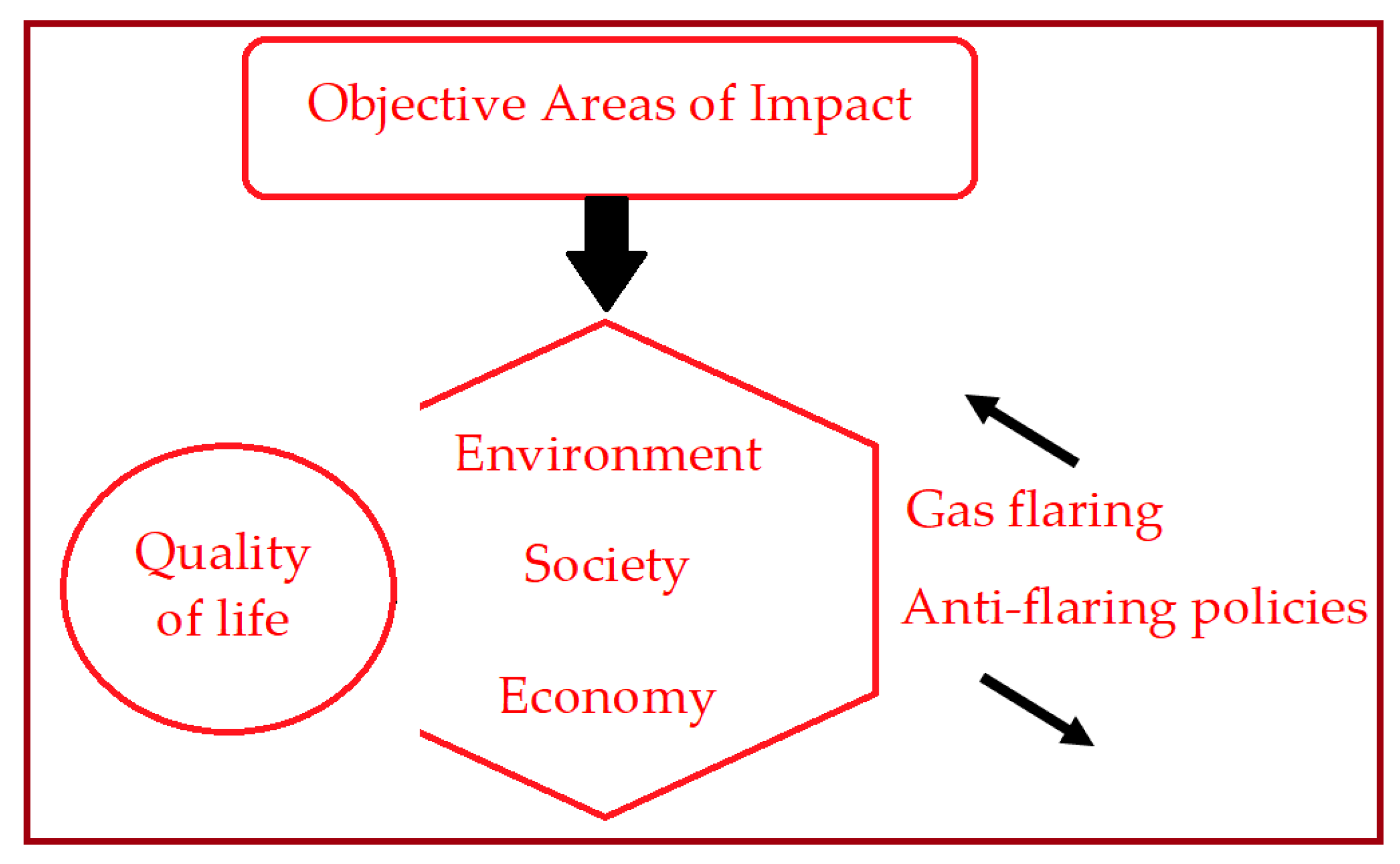
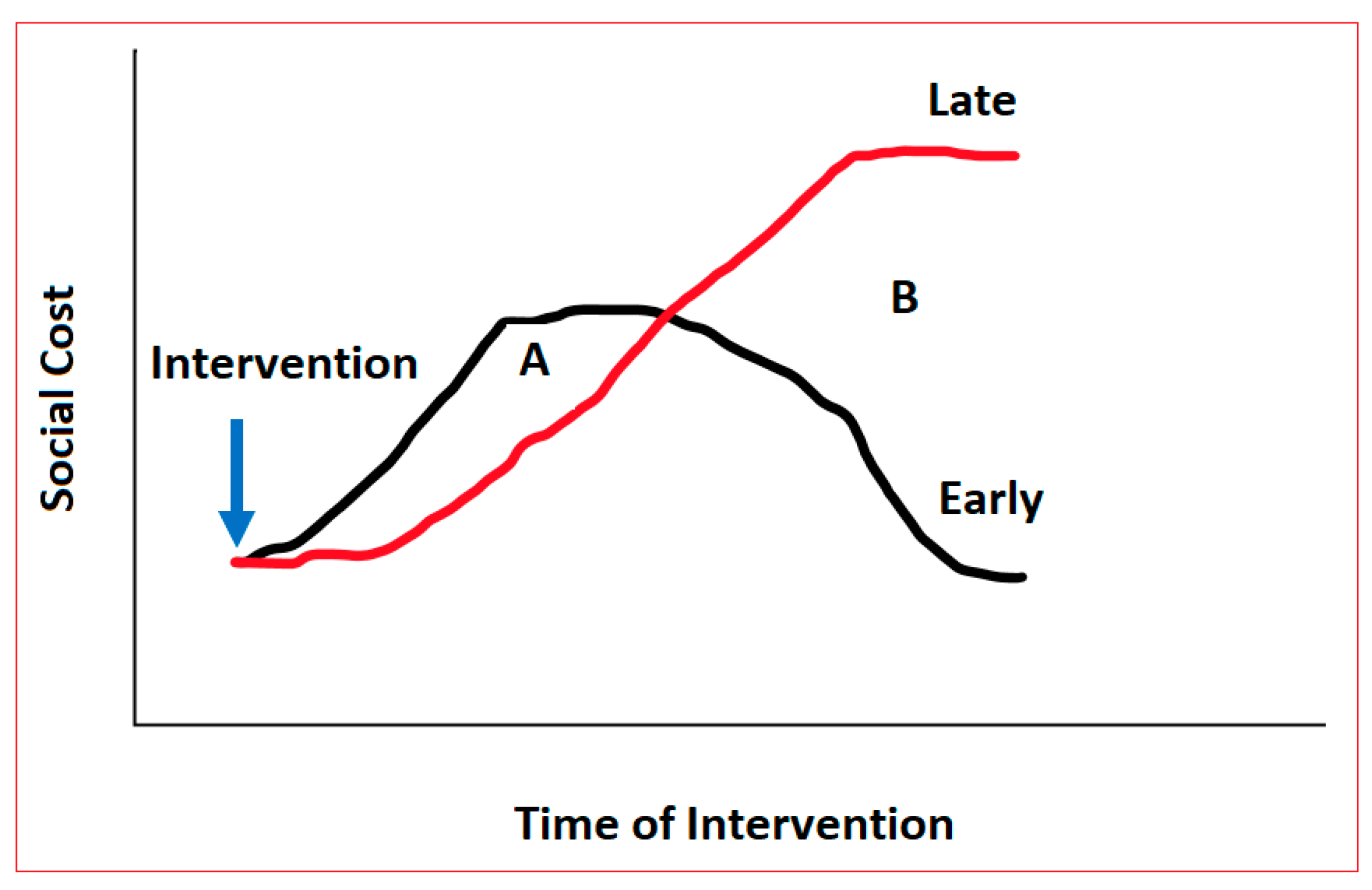



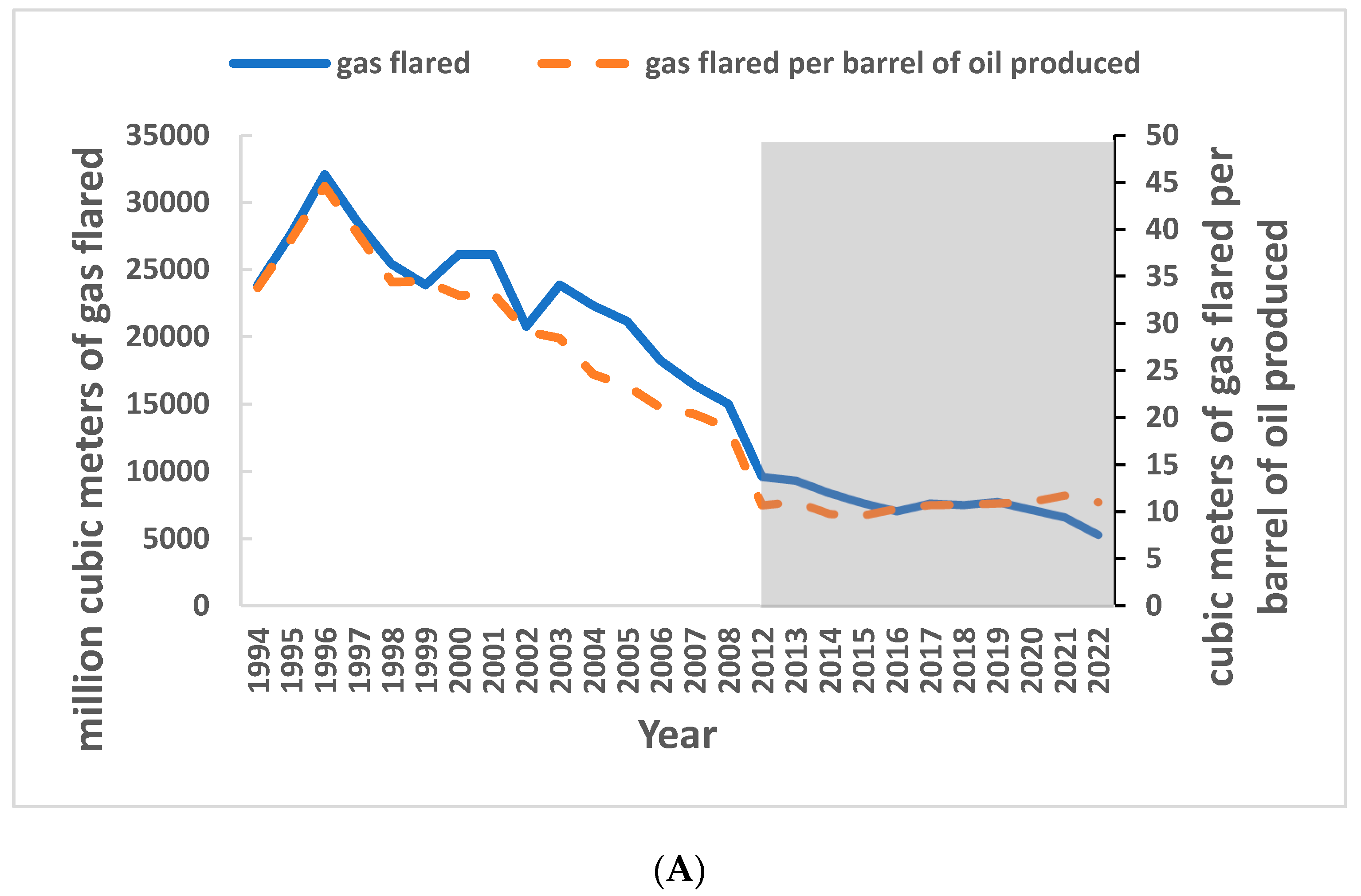
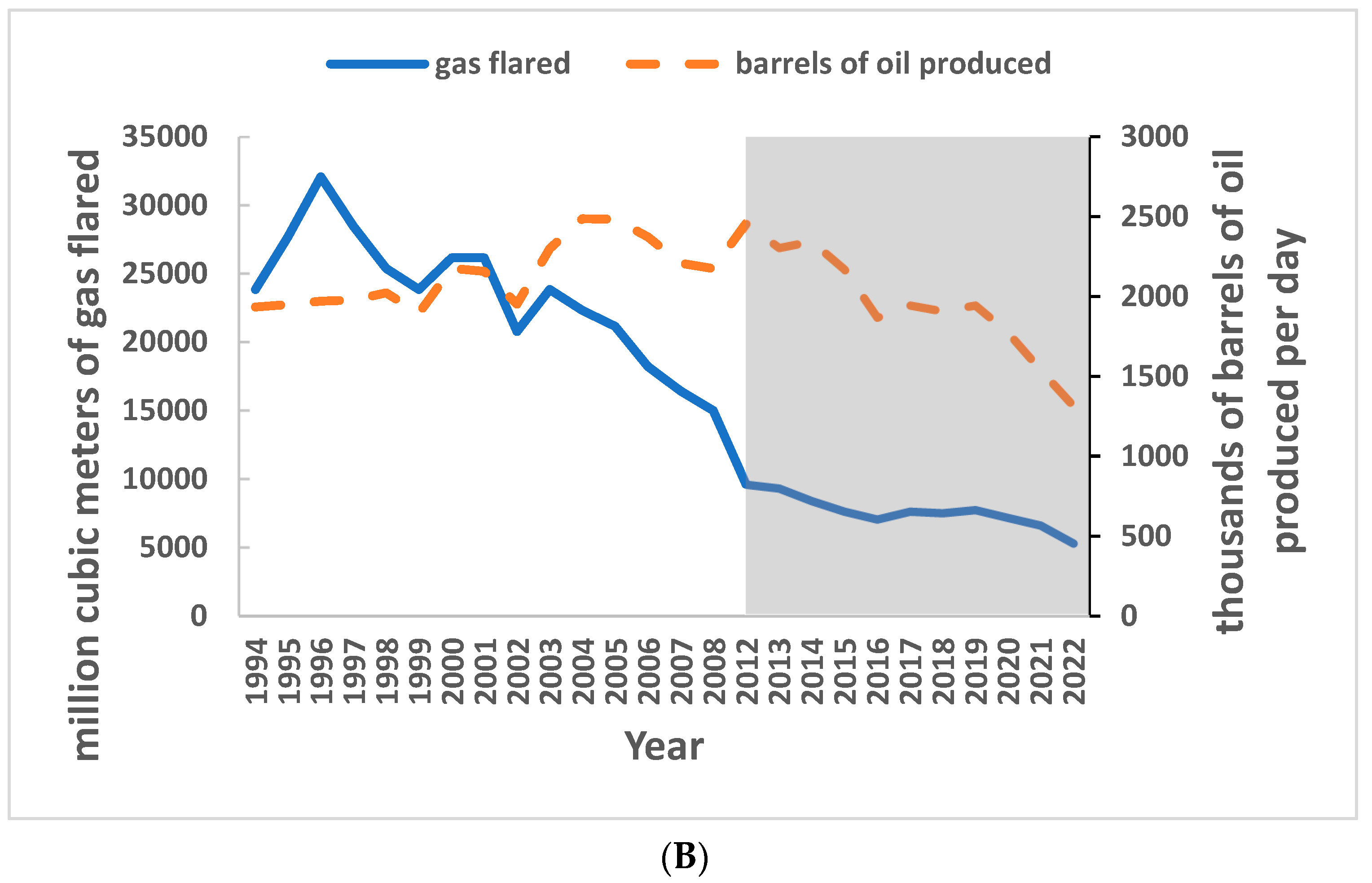
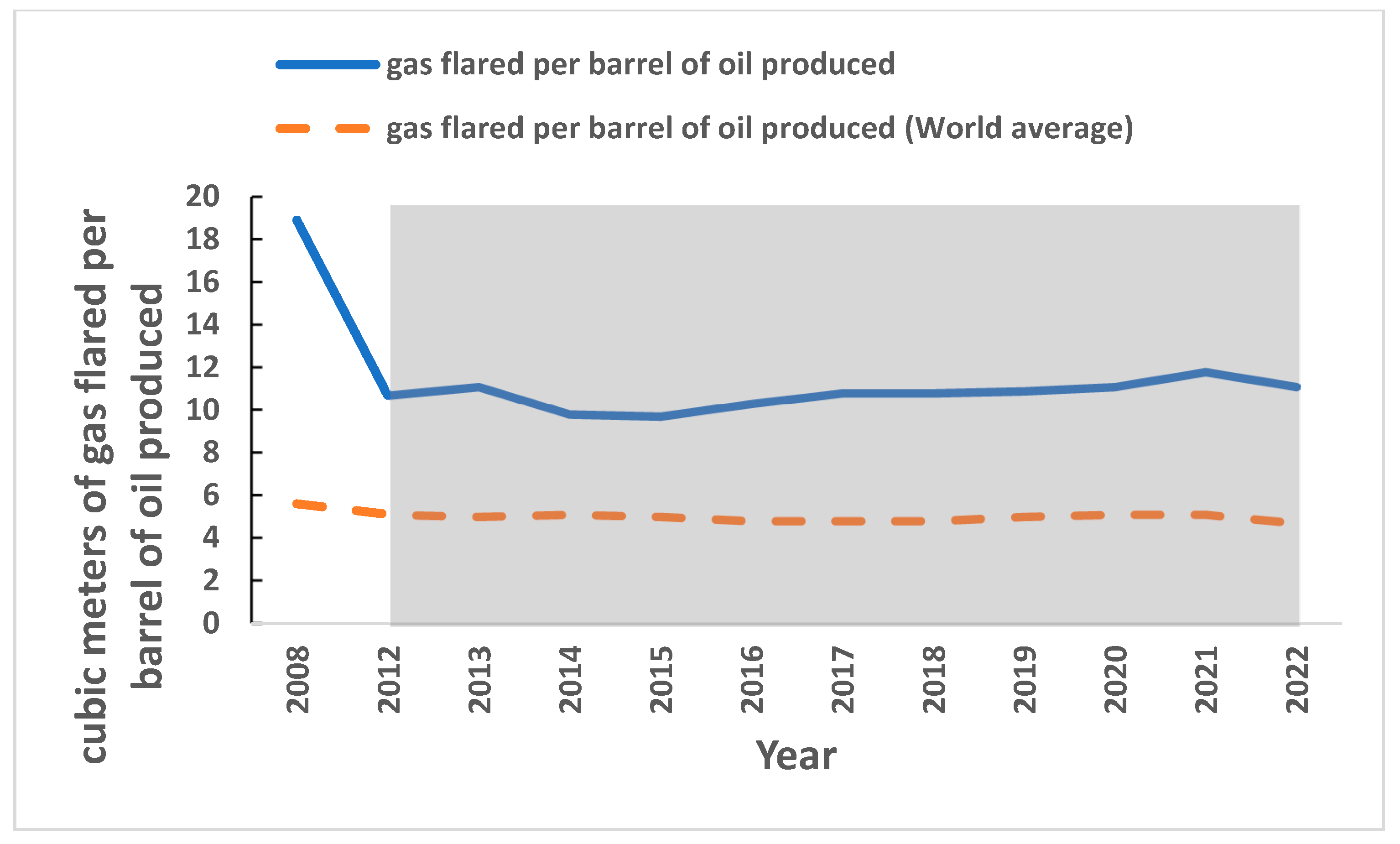
| Area of Impact | Impacts of Gas Flaring |
|---|---|
| Environment | High concentrations of airborne pollutants [53,54,55,56]. Rainwater acidification [43,44,45,46,47]. Soil degradation [37,38]. Contributes to millions of metric tons of CO2 released per year [39]. Loss of biodiversity [43,46,49]. |
| Society | Reductions in crop yield—less food security [37,43,68]. Charring of vegetation due to the heat—less food security [37,39]. Respiratory diseases, with occurrence more frequent the closer the inhabitants are to the gas flare point [43,53,54,55,56,60]. |
| Economy | Loss of earnings for households due to reductions in crop yields [69]. Loss of earnings for households due to reductions in fishing yields [43]. Loss of earnings for the government due to flared gas [21,65,66,67,68,69,70,71,72,73,74,75,76]. Economic losses for individuals and industries due to increased maintenance of infrastructure [43,63,64]. |
| How Does the Gas Flaring Occur? | Examples | Temporal Impact If Unresolved. Relationship to the Flaring Stages in Figure 5. |
|---|---|---|
| Routine gas flaring at an oil production facility during normal operations due to the unavailability of measures to utilize the gas in any form. Continuous. |
| Long-term impact on air quality, rainwater quality, soil quality, crop yields, respiratory diseases, and economic costs. Flaring and post-flaring stages. Pervasive impacts (Figure 5). |
| Non-routine gas flaring. Intermittent. Short duration. Planned or unplanned. |
| Short-term, and possibly medium-term, impact on air quality, rainwater quality, soil quality, crop yields, respiratory diseases, and economic costs. Pre-flaring, flaring, and post-flaring stages. Mostly localized (Figure 5). |
| Safety flaring of gas to enable the safe operation of an oil production facility. Emergency or planned. |
| Short-term, and possibly medium-term, impact on air quality, rainwater quality, soil quality, crop yields, respiratory diseases, and economic costs. Flaring, and post-flaring stages. Mostly localized (Figure 5). |
| What Stage of the Flaring Process? | Strategy | Policy Options |
|---|---|---|
| Pre-flaring stage. The planning stage of the oil exploration/production facility. The facility is not in operation, yet. | Prevent gas flaring. | Associated gas utilization or prevention measures must be part of oil exploration/production plant design before a permit is given. |
| Flaring stage. Oil exploration/production facility in operation. Gas flaring impacts are not yet pervasive. | Improve inspections at exploration/production facilities. Utilize the gas flared. | Strengthen the Department of Petroleum Resources to better monitor, measure, and report gas flares. Review the flaring penalties. Incorporate the smaller gas utilization operators into the gas flare management policies, including the recent gas flare commercialization program. |
| Post-flaring stage. Oil exploration/production facility in operation for long enough for the gas flaring impacts to be pervasive. | Minimize the impacts of gas flaring on human health. Funded by the oil production tax currently in operation. | Relocate inhabitants from pervasively affected areas. Prohibit farming or fishing in pervasively affected areas. |
| At all the flaring stages. Science and data quality. | Bridge the science–policy gap. Improve the data quality. Improve data management. | Fund comprehensive scientific studies on gas flaring. Strengthen the Department of Petroleum Resources to better acquire gas flaring data and manage and share the data with other national and international agencies. |
Disclaimer/Publisher’s Note: The statements, opinions and data contained in all publications are solely those of the individual author(s) and contributor(s) and not of MDPI and/or the editor(s). MDPI and/or the editor(s) disclaim responsibility for any injury to people or property resulting from any ideas, methods, instructions or products referred to in the content. |
© 2024 by the author. Licensee MDPI, Basel, Switzerland. This article is an open access article distributed under the terms and conditions of the Creative Commons Attribution (CC BY) license (https://creativecommons.org/licenses/by/4.0/).
Share and Cite
Emekwuru, N. Characterization of the Dominant Stages at Which Gas Flaring Is Introduced: Impacts and Policy Options to Ameliorate Them. Environments 2024, 11, 158. https://doi.org/10.3390/environments11070158
Emekwuru N. Characterization of the Dominant Stages at Which Gas Flaring Is Introduced: Impacts and Policy Options to Ameliorate Them. Environments. 2024; 11(7):158. https://doi.org/10.3390/environments11070158
Chicago/Turabian StyleEmekwuru, Nwabueze. 2024. "Characterization of the Dominant Stages at Which Gas Flaring Is Introduced: Impacts and Policy Options to Ameliorate Them" Environments 11, no. 7: 158. https://doi.org/10.3390/environments11070158
APA StyleEmekwuru, N. (2024). Characterization of the Dominant Stages at Which Gas Flaring Is Introduced: Impacts and Policy Options to Ameliorate Them. Environments, 11(7), 158. https://doi.org/10.3390/environments11070158






